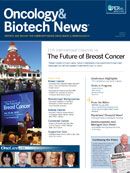Publication
Article
First-Line Dose-Dense Induction and High-Dose Chemotherapy/Autologous Stem Cell Transplant Benefits Patients With Rare Lymphomas
Author(s):
Dose-dense induction with high-dose chemotherapy/autologous stem-cell transplantation is reasonable for use as first-line treatment of transplantation-eligible patients with systemic peripheral T-cell lymphomas.
Francesco d’Amore, MD
Dose-dense induction with high-dose chemotherapy/autologous stem-cell transplantation (HDT/ASCT) is reasonable for use as first-line treatment of transplantation-eligible patients with systemic peripheral T-cell lymphomas (PTCLs), according to the final results of the Nordic Lymphoma Group (NLG) prospective phase II trial NLG-T-01 study.
Francesco d’Amore, MD, associate professor of Hematology at Aarhus University Hospital in Aarhus, Denmark, and colleagues elsewhere treated patients with an induction regimen of six cycles of biweekly CHOEP (cyclophosphamide, doxorubicin, vincristine, etoposide, and prednisone). Because of reports of increased toxicity with weekly CHOEP in elderly patients with diffuse large B-cell lymphoma, etoposide was not given to study participants aged ≥60 years. If determined to be in complete or partial remission, patients underwent consolidation with HDT/ASCT.
Except for ALK-positive anaplastic large-cell lymphoma (ALCL), systemic PTCLs treated with standard therapy have worse outcomes than B-cell lymphomas, the authors wrote. The role of HDT/ASCT is still being explored, and most data to date are from small retrospective series. There have been few prospective studies examining upfront HDT/ASCT in a cohort of exclusively PTCL patients, and most such studies are limited by their small sample size.
Subjects in the NLG-T-01 study ranged from 18 to 67 years of age and had newly diagnosed systemic PTCL. Individuals with ALK-positive ALCL, primary cutaneous, and primary leukemic subtypes were not eligible for the study, which the authors believe to be the largest clinical trial to date in PTCL.
Overall, 160 patients with histologically confirmed PTCL comprised the intent-to-treat population. Of these patients, 115 underwent HDT/ASCT; 90 patients were in complete remission at 3 months posttransplantation. Early failures occurred in 26% of patients, and treatment-related deaths occurred in 4%.
At a median follow-up of 60.5 months, 83 patients were alive. The study’s treatment regimen was associated with an overall survival (OS) and progression-free survival (PFS) of 51% (95% CI, 43%-59%) and 44% (95% CI, 36%-52%), respectively.
Also, patients with ALK-negative ALCL histology had a better outcome. Their 5-year OS was 70% and their 5-year PFS was 61%.
The investigators noted that while patient selection is invariably present in a transplantation study because of age and/or comorbidity criteria, the high median age of the study cohort (57 years) coupled with the adverse risk profile of study participants demonstrate a low selection bias.
They also emphasized that their analysis is based on a “robust” median follow-up, which is longer than the 18- and 33-month median follow-up reported in other recent major prospective PTCL studies.
d’Amore F, Relander T, Lauritzsen GF, et al. Upfront autologous stem-cell transplantation in peripheral T-cell lymphoma: NLG-T-01. J Clin Oncol. 2012;30(25):3093-3099.










